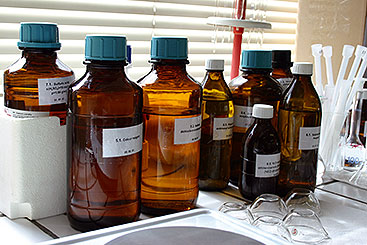Identifying hazardous substances

Identifying hazardous substances
Danube countries are working to fill in knowledge gaps on pollution to create the first national inventories on emissions, discharges and losses of hazardous substances in the Danube River Basin.

This year, members of the ICPDR’s Pressures and Measures Expert Group will oversee the establishment of national inventories on emissions, discharges and losses of hazardous substances.
© ICPDR/Liska
Creating national inventories
There are a number of steps the Danube countries should take to ensure the best data for their national inventories:
- Ensure that analytical methods fulfil the requirements of the EU Quality Assurance/Quality Control Directive
- Use reliable and comparable data
- Make use of the Transnational Monitoring Network and the results of the Joint Danube Survey
- Anticipate future needs to meet the ICPDR’s vision and the EU Water Framework Directive objections.
Hazardous substances pollution can seriously damage riverine ecology and consequently impact the quality status of water bodies. Furthermore, hazardous substances can remain in the environment for a very long time, can bioaccumulate and can harm human health, even in very low concentrations.
While the Danube countries have made a lot of progress in addressing the problems associated with hazardous substances – particularly in taking actions to implement the EU Urban Wastewater Treatment Directive and the Integrated Pollution Prevention and Control Directive – there are still significant gaps in knowledge about hazardous substances in the Danube River Basin.
One of the most important ways to improve knowledge of these substances and their pollution is to develop inventories on emissions, discharges and losses. Moreover, Article 5(4) of the Environmental Quality Standards Directive requires that national inventories be included in the EU Water Framework Directive Report to be carried out by the end of 2013.
A case for national inventories. In 2010, the European Community launched an EU Drafting Group on Priority Substances to develop technical guidelines for the establishment of an inventory on discharges, emissions and losses of priority hazardous substances. The Danube River was chosen as a case study, and the ICPDR’s Pressures and Measures Expert Group used the methods proposed in the EC’s technical guidance document to establish a list of relevant priority substances for the Danube River Basin, and to calculate riverine loads for the relevant substances.
This year, members of the Pressures and Measures Expert Group will oversee the establishment of inventories at the national level. “A tiered approach should be performed by the Danube countries to establish their inventories,” says Elena Tuchiu, Director of the Management Plans Department at the Romanian National Administration Apele Romane. “However, for the first inventory to be completed by the end of this year, Danube countries may need to consider point discharges of priority substances from industrial facilities and municipal wastewater plants.”
Once the national inventories have been completed, the ICPDR will coordinate the compilation of national inventories to ensure a comparable and harmonised development of the first inventory of emissions, discharges and losses for the entire Danube River Basin.
“The knowledge of hazardous substances and their impact on the chemical status of waters will continue to improve as new monitoring data in the next few years will further fill in gaps,” says Madalina David, Senior Expert at Romanian National Administration Apele Romane. “The knowledge from these inventories will help establish measures to address pollution sources and reach [the] priority substances management objective and secure the good chemical status for all water bodies in the Danube River Basin.”






